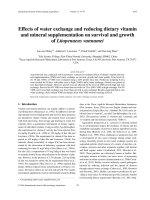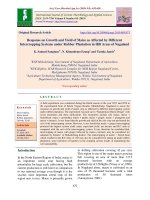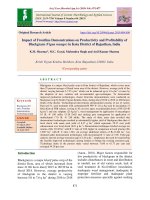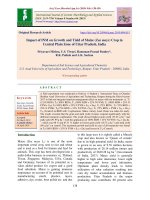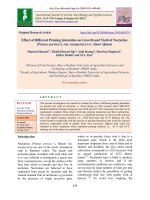Impact assessment on income and employment of krishi vigyan Kendra training programmes in Nagaland
Bạn đang xem bản rút gọn của tài liệu. Xem và tải ngay bản đầy đủ của tài liệu tại đây (500.02 KB, 10 trang )
Int.J.Curr.Microbiol.App.Sci (2018) 7(11): 1892-1901
International Journal of Current Microbiology and Applied Sciences
ISSN: 2319-7706 Volume 7 Number 11 (2018)
Journal homepage:
Original Research Article
/>
Impact Assessment on Income and Employment of Krishi Vigyan Kendra
Training Programmes in Nagaland
Imsunaro Jamir and Amod Sharma*
Department of Agricultural Economics, Nagaland University SASRD Medziphema Campus,
District: Dimapur - 797 106, Nagaland, India
*Corresponding author
ABSTRACT
Keywords
KVK, Impact, Training,
Discipline, Assessment,
Programme, Yield,
Income, Employment
Article Info
Accepted:
15 October 2018
Available Online:
10 November 2018
The present study on access the impact of Krishi Vigyan Kendra (KVK's) for conducting
the training programmes in their respective district of the Nagaland state during the year
2012-13 to 2016-17 (five years) and also to assess the impact of income as well as
employment generated for that purpose it was categorized into two groups viz., adopted
and non-adopted villages (80 respondents to each category which make a total of 160
respondents). To achieve the objectives of the present study a multi stage purpose random
sampling methods was adopted. In general, to cover the different aspects 12 numbers of
discipline were selected to assess the income and employment, so the overall annual
income may be increased by the KVK's adopted villages if the re-allocation of the selected
variable were made adjustment for the effectiveness of the different schemes / programme
implemented in both the district through different activities to enhanced the income and
employment.
Introduction
Nagaland, the 16th State of the Indian Union,
came into being on 01st December 1963.
Nagaland with a geographical area of about
16,579 Sq. Km. lies between 25°60‟ and
27°40‟ North latitude and 93°20‟ and 95°15‟
East longitude. The state is bounded by Assam
in the North and West, by Myanmar and
Arunachal Pradesh in the East and by Manipur
in the South. Nagaland, being one of the
“eight Sisters” commonly called as the NorthEastern Region including Sikkim, is a land of
lush green forests, rolling Mountains,
enchanting valleys, swift flowing streams and
of beautiful landscape. The inhabitants of
Nagaland are almost entirely tribal with
distinctive dialects and cultural features
(Annon, 2017).
The state is predominantly rural with 82.26
per cent of population living in villages. The
state comprises of 11 administrative
headquarters with 52 blocks and 1,278
inhabited villages. Each district has generally
predominance / concentration of one of the
major / minor tribe of the state, thereby
making districts distinct in their linguistic,
cultural, traditional and socio-political
characteristics. The topography of Nagaland is
much dissected, full of hill ranges, which
break into a wide chaos of spurs and ridges.
1892
Int.J.Curr.Microbiol.App.Sci (2018) 7(11): 1892-1901
The terrain is mountainous covered by rich
and varied biodiversity of flora and fauna. It is
one of the 25 hot spots of the world with
respect to its biological diversity, and hence
can be termed as the state of true Mega biodiversity. The state houses the confluence of
flora and fauna of the neighbouring regions.
Geographically, the state largely has vast
undulating terrain and hilly landscape and
some low lying areas giving rise to a very
conducive climate with presence of perennial
water and moisture for truly rich variety of
flora and fauna (Anon., 2017).
The state also has abundant resources of
mineral wealth in the form of vast deposits of
Oil, Coal, Peat, Limestone, Iron ores and
various other minerals. The potential of this
state in terms of the sheer variety of Agro and
Horticultural produce including Fiber, Tea,
Coffee, Pineapple, Orange etc. is also
immense. In spite of this inherent potential,
the state has not developed. The current
practice of agriculture is largely unsustainable
owing to the traditional Jhum (Shifting
cultivation) cycle mode of operation. Though
some dynamic initiatives (e. g; by various
government, Department, NGO‟s etc.) are in
action to mitigate the detrimental effects of
Jhum, a lot still needs to be done on various
fronts including efforts on checking
deforestation,
control
of
wild
fire,
conservation of biodiversity, proper water
harvesting, use of non-conventional energy
sources etc.
The
state
also
lacks
infrastructure
development in terms of networking with the
rest of the country, lack of proper
communication in terms of roads and
information technology.
Krishi Vigyan Kendras (Farm Science
Centre), an innovative science based
institutions, are the only district - level
institutions with a proven potentiality to build
farmers‟ capacity on their multi-dimensional
requirements in a scientific and systematic
approach which is established mainly to
impart vocational training to the farmers and
field level extension workers. The concept of
vocational training in agriculture through
KVK grew substantially due to greater
demand for improved agricultural technology
by the farmers. They not only required
knowledge and understanding of the intricacy
of technologies, but also progressively more
and more skills in various complex
agricultural operations for adoption on their
farms.
The effectiveness of the KVK was further
enhanced by adding the activities related to
on-farm testing and Front-Line Demonstration
on major agricultural technologies in order to
make the training of farmers location specific,
need based and resource-oriented. The training
programmes were designed to impart the latest
knowledge to the farmers through work
experience by applying the principles of
„Teaching by Doing‟ and „Learning by
Doing‟.
The prime goal of KVK is to impart training
as per needs and requirements in agriculture
and allied enterprises to all farmers, farm
women and farm youths including school
drop-outs in the rural area. While designing
the courses, the concept of farming system as
well as farming situation are taken into
account to ensure that the enterprises in which
they are trained are commercially and
ecologically viable, sustainable and profitable.
Such vocational trainings help them to sustain
themselves through self-employment and to
make them self-reliant economically and thus
discourages them to migrate to the urban
areas. KVKs provide training not only in
agriculture and allied vocations but also in
other income-generating activities that may
supplement the income of farm families. The
methods employed in training could be formal
1893
Int.J.Curr.Microbiol.App.Sci (2018) 7(11): 1892-1901
and non-formal or a combination of both,
depending upon the needs but emphasis
remains to be on work-experience. The
programme of each KVK covers training, onfarm
trials,
frontline
demonstrations,
agricultural
extension
and
livelihood
activities. Keeping in view the above fact, the
present study is undertaken to access the
Impact of KVK‟s training in terms of income
and employment.
Materials and Methods
The present study is to access the impact of
KVK for disseminating the agriculture
technology to the farming community in
Nagaland state, which is working as per the
guideline of Central Government with the help
of Ministry of Agriculture, Government of
India. Since the intensive KVK started in
1988-89, so it is worth -while to study its
impact.
Since the data of the initial period cannot be
compared with the data of recent years, it is
more scientific and practical to compare the
economy of the beneficiaries / trainees
covered in the area of KVK schemes. The
KVK was launched in 1988-89 in all 11
districts viz; Dimapur, Kohima, Kheprie,
Longleng, Mokokchung, Mon, Phek, Peren,
Tuensang, Wokha and Zunhebuto of
Nagaland, out of these districts two district
viz; Mokokchung and Zunhebuto districts of
Nagaland have been selected because of the
fact that it is expected to provide all the
relevant information and hence can
conveniently be obtained for conducting this
study.
Keeping all the above facts, both districts of
Nagaland are therefore purposively selected to
conduct this study. Two blocks from each
district will be selected randomly for the
present study as these blocks are well covered
by KVK programme. Altogether eight villages
were selected randomly from each district,
while four villages from each block were
selected and listed which would be obtained
from the offices of SDO (Civil), R. D. block
headquarter and other related offices.
However, it is proposed to select four villages
from each block randomly covered for KVK
programme / schemes. After selection of the
villages, a list of beneficiaries and nonbeneficiaries of KVK will be prepared from
each of the selected village. In order to have
representative sample from each village a
sample of 20 numbers of cases of KVK, out of
that 10 from beneficiaries and 10 from nonbeneficiaries will be drawn following the
purposively random sampling method. This
will result in selection of 160 respondents
from 8 villages, out of which 80 will be
beneficiaries of KVK schemes and 80 will be
non-beneficiaries of KVK schemes.
Results and Discussions
Table 1 reveals the status of area (in acre) and
yield (in kg) for the different food grain crops
which was selected for the large and overall
farm size groups, as both the farm were found
to be significant at 1 and 5 per cent level on
the cereals and pulses crops, respectively.
While the oilseed crop on marginal, medium
and overall farm size were found to be
significant at 1 and 5 per cent level on area,
yield was also recorded as significant too.
Whereas the horticultural aspects overall area
and yield both were found to be significant on
both the marginal and small farm size group,
even the yield also found to be significant at 5
per cent level. The marginal, medium and
overall farm size group for the other crops
were found to be significant at 1 and 5 per
cent level. However, on the marginal, small
and medium farm size group the
miscellaneous crop were found to be
significant at 1 and 5 per cent level of
probability, respectively.
1894
Int.J.Curr.Microbiol.App.Sci (2018) 7(11): 1892-1901
Table.1 Status of area (acre) and yield (Kg) for different food grains crops
Category
Marginal
Small
Medium
Overall
Category
Marginal
Small
Medium
Overall
Category
Marginal
Small
Medium
Overall
Category
Marginal
Small
Medium
Overall
Category
Marginal
Small
Medium
Overall
Category
Marginal
Small
Medium
Overall
Category
Marginal
Small
Medium
Overall
Category
Marginal
Small
Medium
Overall
1. a. Cereals
Before
19
47
14
80
1. b. Cereals
20
46
14
80
2. a. Pulses
55
15
10
80
2. b. Pulses
61
9
10
80
3. a. Oilseeds
64
7
9
80
3. b. Oilseeds
63
8
9
80
4. a. Horticult
55
11
14
80
4. b. Horticut
60
12
8
80
%
23.75
58.75
17.50
100.00
After
16
45
19
80
25.00
57.50
17.50
100.00
17
44
19
80
68.75
18.75
12.50
100.00
52
12
16
80
76.25
11.25
12.50
100.00
55
10
15
80
80.00
8.75
11.25
100.00
54
11
15
80
78.75
10.00
11.25
100.00
52
14
14
80
68.75
13.75
17.50
100.00
51
14
15
80
75.00
15.00
10.00
100.00
51
10
19
80
1895
Area (acre)
%
Impac Difference %
20.00
3
3.75
56.25
2
2.50
23.75
5
6.25
100.0
10
12.50
Yield (Kg)
21.25
3
3.75
55.00
2
2.50
23.75
5
6.25
100.0
10
12.50
Area (acre)
65.00
3
3.75
15.00
3
3.75
20.00
6
7.50
100.0
12
15.00
Yield (Kg)
68.75
6
7.50
12.50
1
1.25
18.75
5
6.25
100.0
12
15.00
Area (acre)
67.50
10
12.50
13.75
4
5.00
18.75
6
7.50
100.0
20
25.00
Yield (Kg)
65.00
11
13.75
17.50
6
7.50
17.50
5
6.25
100.0
22
27.50
Area (acre)
63.75
4
5.00
17.50
3
3.75
18.75
1
1.25
100.0
8
10.00
Yield (Kg)
63.75
9
11.25
12.50
2
2.50
23.75
11
13.75
100.0
22
27.50
't' test
NS
NS
*
*
NS
NS
*
*
NS
NS
*
**
*
NS
*
**
*
NS
*
**
**
*
*
**
NS
NS
NS
*
*
NS
*
**
Int.J.Curr.Microbiol.App.Sci (2018) 7(11): 1892-1901
Category
Marginal
Small
Medium
Overall
Category
Marginal
Small
Medium
Overall
Category
Marginal
Small
Medium
Overall
Category
Marginal
Small
Medium
Overall
5. a. Other crop
59
12
9
80
5. b. Other crop
56
16
8
80
6. a. Mis. crops
50.4
18.4
11.2
80
6. b. Mis. crops
52
18.2
9.8
80
73.75
15.00
11.25
100.00
51
15
14
80
70.00
20.00
10.00
100.00
52
12
16
80
63
23
14
100
44.8
19.4
15.8
80
65
22.75
12.25
100
45.4
18
16.6
80
Area (acre)
63.75
8
18.75
3
17.50
5
100.0
16
Yield (Kg)
65.00
4
15.00
4
20.00
8
100.0
16
Area (acre)
56
5.6
24.25
3
19.75
4.6
100.0
13.2
Yield (Kg)
56.75
6.6
22.5
3
20.75
6.8
100.0
16.4
10.00
3.75
6.25
20.00
*
NS
*
**
5.00
5.00
10.00
20.00
NS
NS
*
**
17
3.75
5.75
16.5
**
NS
*
**
8.25
3.75
8.5
15.75
*
NS
*
**
(** & * Significant at 1, 5 per cent level of significant, NS: Non Significant)
Table.2 Status of income and employment through KVK interventions
1.a. Agronomy
Before
Marginal 18
Small 54
Medium 8
Overall 80
1. b. Agronomy
Marginal 17
Small 53
Medium 10
Overall 80
2.a. Horticulture
Marginal 6
Small 60
Medium 14
Overall 80
2. b. Horticulture
Before
Marginal 8
Small 68
Medium 4
Overall 80
3. a. Entomology
%
22.50
67.50
10.00
100.00
After
14
56
10
80
21.25
66.25
12.50
100.00
13
55
12
80
7.50
75.00
17.50
100.00
4
58
18
80
%
10.00
85.00
5.00
100.00
After
6
68
12
80
1896
Income
%
Impact
17.50
4
70.00
2
12.50
2
100.00
8
Employment
16.25
4
68.75
2
15.00
2
100.00
8
Income
5.00
2
72.50
2
22.50
4
100.00
8
Employment
%
Impact
7.50
2
85.00
0
15.00
8
107.50
10
Income
Impact %
5.00
2.50
2.50
10.00
't' test
NS
NS
NS
*
5.00
2.50
2.50
10.00
NS
NS
NS
*
2.50
2.50
5.00
10.00
NS
NS
NS
*
Impact %
2.50
0.00
10.00
12.50
't' test
NS
NS
*
*
Int.J.Curr.Microbiol.App.Sci (2018) 7(11): 1892-1901
Marginal 0
0.00
Small 68
85.00
Medium 12
15.00
Overall 80
100.00
3. b. Entomology
Marginal 0
0.00
Small 69
86.25
Medium 11
13.75
Overall 80
100.00
4. a. PLP
Marginal 0
0.00
Small 76
95.00
Medium 4
5.00
Overall 80
100.00
4. b. PLP
Marginal 0
0.00
Small 75
93.75
Medium 5
6.25
Overall 80
100.00
5. a. Soil Science
Marginal 18
22.50
Small 50
62.50
Medium 12
15.00
Overall 80
100.00
5. b. Soil Science
Marginal 28
35.00
Small 44
55.00
Medium 8
10.00
Overall 80
100.00
6. a. Fishery Science
Marginal 0
0.00
Small 66
82.50
Medium 14
17.50
Overall 80
100.00
6. b. Fishery Science
Marginal 0
0.00
Small 76
95.00
Medium 4
5.00
Overall 80
100.00
7. a. Home Science
Before
%
Marginal 0
0.00
Small 76
95.00
Medium 4
5.00
Overall 80
100.00
7. b. Home Science
Marginal 0
0.00
Small 76
95.00
Medium 4
5.00
Overall 80
100.00
8. a. Post Harvest Management
0
65
15
80
0
68
12
80
0
74
6
80
0
73
7
80
12
52
16
80
22
42
16
80
0
64
16
80
0
74
6
80
After
0
74
6
80
0
75
5
80
1897
0.00
0
81.25
3
18.75
3
100.00
6
Employment
0.00
0
85.00
1
15.00
1
100.00
2
Income
0.00
0
92.50
2
7.50
2
100.00
4
Employment
0.00
0
91.25
2
8.75
2
100.00
4
Income
15.00
6
65.00
2
20.00
4
100.00
12
Employment
27.50
6
52.50
2
20.00
8
100.00
12
Income
0.00
0
80.00
2
20.00
2
100.00
4
Employment
0.00
0
92.50
2
7.50
2
100.00
4
Income
%
Impact
0.00
0
92.50
2
7.50
2
100.00
4
Employment
0.00
0
93.75
1
6.25
1
100.00
2
Income
0.00
3.75
3.75
7.50
NS
NS
NS
*
0.00
9.09
1.25
10.34
NS
*
NS
*
0.00
2.50
2.50
5.00
NS
NS
NS
NS
0.00
2.50
2.50
5.00
NS
NS
NS
NS
7.50
2.50
5.00
15.00
*
NS
NS
**
7.50
2.50
10.00
15.00
*
NS
*
**
0.00
2.50
2.50
5.00
NS
NS
NS
NS
0.00
2.50
2.50
5.00
NS
NS
NS
NS
Impact %
0.00
2.50
2.50
5.00
't' test
NS
NS
NS
NS
0.00
1.25
1.25
2.50
NS
NS
NS
NS
Int.J.Curr.Microbiol.App.Sci (2018) 7(11): 1892-1901
Marginal 16
20.00
14
17.50
2
Small50
62.50
48
60.00
2
Medium 14
17.50
18
22.50
4
Overall 80
100.00
80
100.00
8
8. b. Post Harvest Management
Employment
Marginal 22
27.50
18
22.50
4
Small 48
60.00
46
57.50
2
Medium 10
12.50
16
20.00
6
Overall 80
100.00
80
100.00
12
9. a. Tailoring
Income
Marginal 0
0.00
0
0.00
0
Small 71
88.75
70
87.50
1
Medium 9
11.25
10
12.50
1
Overall 80
100.00
80
100.00
2
Employ
9. b. Tailoring
Marginal 0
0.00
0
0.00
0
Small 72
90.00
70
87.50
2
Medium 8
10.00
10
12.50
2
Overall 80
100.00
80
100.00
4
10. a. Cottage Industries
Income
Marginal 0
0.00
0
0.00
0
Small 75
93.75
73
91.25
2
Medium 5
6.25
7
8.75
2
Overall 80
100.00
80
100.00
4
10. b. Cottage Industries
Employment
Marginal 0
0.00
0
0.00
0
Small 70
87.50
67
83.75
3
Medium 10
12.50
13
16.25
3
Overall 80
100.00
80
100.00
6
11. a. Small Scale Industries
Income
Marginal 0
0.00
0
0.00
0
Small 76
95.00
74
92.50
2
Medium 4
5.00
6
7.50
2
Overall 80
100.00
80
100.00
4
11. b. Small Scale Industries
Employment
Before
%
After
%
Impact
Marginal 0
0.00
0
0.00
0
Small 76
95.00
73
91.25
3
Medium 4
5.00
7
8.75
3
Overall 80
100.00
80
100.00
6
12. a. Others
Income
Marginal 0
0.00
0
0.00
0
Small 78
97.50
74
92.50
4
Medium 2
2.50
6
7.50
4
Overall 80
100.00
80
100.00
8
12. b. Others
Employment
Marginal 0
0.00
0
0.00
0
Small 79
98.75
75
93.75
4
Medium 1
1.25
5
6.25
4
Overall 80
100.00
80
100.00
8
(** & * Significant at 1, 5 per cent level of significant, NS: Non Significant)
1898
2.50
2.50
5.00
10.00
NS
NS
NS
*
5.00
2.50
7.50
15.00
NS
NS
*
**
0.00
1.25
1.25
2.50
NS
NS
NS
NS
0.00
2.50
2.50
5.00
NS
NS
NS
NS
0.00
2.50
2.50
5.00
NS
NS
NS
NS
0.00
3.75
3.75
7.50
NS
NS
NS
NS
0.00
2.50
2.50
5.00
NS
NS
NS
NS
Impact %
0.00
3.75
3.75
7.50
't' test
NS
NS
NS
NS
0.00
5.00
5.00
10.00
NS
NS
NS
*
0.00
5.00
5.00
10.00
NS
NS
NS
*
Int.J.Curr.Microbiol.App.Sci (2018) 7(11): 1892-1901
Table 2 reveals the status of income and
employment generated after the adopted of
KVK's scheme / programme implemented /
launched with special reference to the
selected 12 (Twelve) different disciplines
prevailing in the research selected field /
areas
viz;
agronomy,
horticulture,
entomology, tailoring, plant pathology, soil
science, fishery science, home science, postharvest management, cottage industries,
small scale industries,
Others all the selected variables were assess
the impact on income and employment
generated however only six (50.00 per cent)
of them were having positive response,
while remaining 50.00 per cent were found
to be non-significant role with reference to
generate income and employment.
Out of the 12 selected variables the
agronomical as well as horticultural both the
aspects on the income and employment
were found to be significant on overall farm
size at 5 per cent level, however on
horticulture aspects on the medium farm
size employment was also found to be
significant at 5 per cent level, respectively.
The entomology aspects was found to be
significant on overall farm size group with
reference to income and employment, even
the small farm size group was found to be
significant at 5 per cent level of probability.
The soil science aspects was found to be
significant on both the farm size group
marginal and overall with reference to
income and employment, even on the large
farm size group employment was found to
be significant at 5 per cent level of
probability.
The post-harvest management aspect was
found to be significant on overall farm size
group on income and employment both,
even the employment aspect was also found
to be significant on employment at 5 per
cent level. Lastly the other aspects on
overall farm size group were found to be
significant at 5 per cent level of probability,
respectively.
Policy Implications
The
following
policies
may
be
recommended for the implementation based
on the research / field work was carried out
for the betterment in the future.
Through market intelligence, market
research and marketing extension in the area
the marketing margin should be improved.
To make the farmers easily accessible for
selling their produce in less time in the
nearby market area with less damage and
losses the proper transportation system is
required.
The agriculture extension workers need to
gear up their activities with full force to
train the farmers for the effective control of
insect, pest and diseases.
To avoid the price fluctuation of the
produce and for improvisation of the
marketing system, government should
establish a regulate market in the local
areas.
References
Ahmad Nafees Singh SP and Parihar P.
2012. Farmer‟s Assessment of KVK
training
programme.
Economic
Affairs. 57(2): 165-168.
Analogous. 2017. Statistical Hand of
Nagaland Published by Directorate of
1899
Int.J.Curr.Microbiol.App.Sci (2018) 7(11): 1892-1901
Economics and Statistics (various
issues), Kohima, Nagaland.
Dhakre, D. S. and Sharma, Amod. 2010.
Socio-Economic Development in
India. Environment and Ecology. 4(1):
2469-2472.
Dubey AK Srivastva JP Singh RP and
Sharma VK 2008. Impact of KVK
training programme on socioeconomic status and knowledge of
trainees in Allahabad district. Indian
Research Journal of Extension
Education. 8(2-3): 60-61.
Gaikwad SP Godase SS Tambe BN. 2011.
Knowledge gained by farmer by
participating in field days organized
by K.V.K. Pune. International Journal
of Agricultural Sciences. 7(2): 460461.
Kadam MS Pandya RD Kolgane BT and
Khogare DT. 2012. Constraints faced
by the experts working at KVK‟s.
Agriculture Update. 7(1-2): 102-164.
Mishra RP Singh AK and Chaudhary RP.
2005. Impact of KVK on farm women
development. Farm Science Journal.
14(1): 67-68.
Pongener, Bendangjungla and Sharma,
Amod. 2018. Constraints Faced by the
Fishery Enterprises: A SWOC
Analysis. IJCMAS. 7(5). May: 15951603.
Rao NV Ratnakar R and Jain PK. 2012.
Impact of farmer field schools in KVK
adopted villages on level of
knowledge and extent of adoption of
improved practices of paddy (Oryza
sativa L.). Journal of Research
ANGRAU. 40(1): 35-41.
Sharma, A. and Sharma, Anamika. 2008.
Problems faced by the farmers in
adoption
of
improved
maize
cultivation practices in hills. TJRAR.
8(2): 22-23.
Sharma, Amod. 2011. Economic and
Constraints of King Chilli Growers in
Dimapur District of Nagaland. Journal
of Interacademicia. 15(4): 710-719.
Sharma, Amod. 2012. Inter-state Disparities
in Socio-economic Development in
North East Region of India. Journal of
Agricultural Science. 4(9). September:
236-243.
Sharma, Amod.; Kichu, Yimkumba. and
Sharma, Pradeep. Kumar. 2018.
Sustainable economic analysis and
constraints faced by the pineapple
growers in Nagaland. Progressive
Agriculture. 18(1). February: 27-33.
Sharma, Amod; Kichu, Yimkumba. and
Chaturvedi, B. K. 2016. Economics
and
Constraints
of
Pineapple
Cultivation in Dimapur District of
Nagaland. TJRAR. 16(1). January: 7275.
Shuya, Keviu. and Sharma, Amod. 2014.
Impact and constraints faced by the
borrowers of cooperative bank finance
in Nagaland. Economic Affairs. 59(4).
October: 561-567.
Shuya, Keviu. and Sharma, Amod. 2018.
Problems faced by the Borrowers in
Utilization
and
Acquiring
of
Cooperative Bank Loans in Nagaland.
IJED. 14(2). April-June: 52-56.
Singh Dan Singh RP Singh RL and Singh
Surat. 2007. Assessment of training
programmes of KVK Rampur, its
duration and preference time of
training programmes. Progressive
Research. 2(1-2): 126-128.
Walling, Imti. and Sharma, Amod. 2015.
Impact of SGRY on beneficiaries and
non-beneficiaries in Dimapur district
of Nagaland. TJRAR. 15(2). August:
90-94.
Walling, Imti.; Sharma, Amod.; Yadav,
Mukesh. Kumar.; Rajbhar, Arun,
Kumar. and Kalai, Kankabati. 2017.
1900
Int.J.Curr.Microbiol.App.Sci (2018) 7(11): 1892-1901
Impact of Agricultural Technology
Management Agency on Rural
Economy of Nagaland, India. Plant
Archiver. 17(2). October: 1511-1516.
Yerpude Seema and Khare NK. 2003.
Constraints in participation of tribal
women in watershed programme.
Indian
Journal
of
Extension
Education. 3(2): 87-88.
How to cite this article:
Imsunaro Jamir and Amod Sharma. 2018. Impact Assessment on Income and Employment
of Krishi Vigyan Kendra Training Programmes in Nagaland. Int.J.Curr.Microbiol.App.Sci.
7(11): 1892-1901. doi: />
1901


